Football Defensive Formations: A Guide for Coaches & Players
Reading Time: 11 minutes
Reading Time: 11 minutes
Defensive formations in gridiron football set the foundation to combat opposing offensive schemes. Defensive coordinators align players in specific formations that counter the opponent’s offensive formations, strategy, and strengths depending on a given look or insight gained through film review and game planning.
Numerous defensive formations exist – from common base defenses to niche variations designed for specific personnel. As the game transformed over time, so have defensive formations. Some formations are tailored to youth football while others are more complex and only used in advanced leagues.
In this resource, you’ll gain a high-level understanding of football defensive formations. Continue reading to learn:
- What defensive formations are in gridiron football
- Key factors of defensive formations
- Players that make up defensive formations
- Types of coverage in defensive formations
- Basic, pass-first, and other defensive formations
- FAQs about football defensive formations
What Are Defensive Formations In Football?
In American football, defensive formations are the alignment of defensive players before a play starts.
Defensive formations dictate:
- How players are positioned
- Their responsibilities during the play, and
- The effectiveness of a defense
Unlike football defensive schemes which incorporate strategy, defensive formations solely refer to the alignment of players.
Naming convention for defensive football formations
The common naming convention for football defensive formations provides an overview of the alignment – specifically the number of defensive linemen and linebackers.
Typically, defensive formations are named # of defensive linemen – # of linebackers.
- For example, 4-3 defensive alignment incorporates four defensive linemen (4) and three linebackers (3).
Key Factors of Football Defensive Formations
To understand how defensive formations work in football, you need to be aware of a few key factors that determine them.
Specifically:
- The players that make up defensive formations, and
- Types of coverage
Defensive Players The Make Up Formations
As previously mentioned, formations are named by the players that make up the specific alignment. On defense, that includes defensive linemen, linebackers, and defensive backs.
Defensive linemen
Defensive linemen are positioned directly on the line of scrimmage, across from opposing offensive linemen. Two positions make up the defensive line: defensive tackles and defensive ends.
- Defensive tackle (DT) lines up in the interior of the defensive line, opposite the offensive guard. They’re tasked with rushing the passer, knocking down passes, and stopping running plays.
- Nose tackles (NT) – also known as middle guard or nose guard – line up directly in front of the center in certain formations.
- Defensive end (DE) lines up on the outside of the defensive line, across from the offensive tackle. They’re tasked with pressuring the quarterback and stopping running plays – especially to the outside. In some formations, defensive ends drop into pass coverage or defend against screen passes.
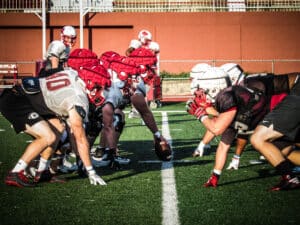
Linebacker
Linebackers are positioned behind the defensive line, typically in a two point stance. The linebacker position plays multiple roles in a defense. They cover receivers and passing zones, rush the passer, and defend against the run. They’re split into two types: middle linebacker (MLB) and outside linebacker (OLB).
- Middle linebacker (MLB) serves as the quarterback of the defense, relaying the playcall. They are also referred to as inside linebackers (ILB) and hold multiple responsibilities: cover pass plays and zones across the middle of the field, stop running plays that get past the defensive line, and rush the quarterback on blitzes.
- Outside linebacker (OLB) plays on opposite sides of the MLB. They serve the same responsibilities as the MLB, but they aren’t in charge of relaying play calls. Two variations of OLB include strongside linebacker (SLB) and weakside linebacker (WLB).
- SLB – also known as Sam – lines up on the same side as the offensive tight end, covering them or running backs on pass plays.
- WLB – also known as Will – lines up on the side of the offensive line without a tight end in 11 personnel, and blitzes the quarterback or covers the running back on passing plays.
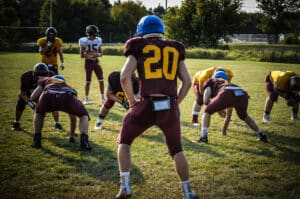
Defensive backs
Defensive backs – also known as the secondary – line up behind linebackers or outside near the sidelines. Their job is to defend against pass plays, serve as the last defense against running plays that escape the linemen and linebackers, and rush the quarterback on specialty blitzes. The secondary is broken down into two position types: cornerbacks and safeties.
- Cornerbacks (CB) prevent pass plays and contain runners. They line up against receivers at the line of scrimmage and cover individual receivers in man-to-man or protect a defined area in zone coverage. In certain formations – specifically pass coverage – the defense removes a linebacker or lineman in exchange for an extra defensive back. A nickelback is a fifth defensive back and a dimeback is a sixth defensive back.
- Safeties (S) are the last line of protection for the defense. They line up furthest away from the line of scrimmage and help protect against pass plays and stop runners. The strong safety (SS) is often larger and stronger, defending the side of the field the tight end lines up on. Free safety (FS) is the faster of the two, positioned deep to cover long pass plays.

Types of Coverage in Defensive Formations
Most formations allow teams to call multiple types of defensive plays. The two overarching defensive coverages are man-to-man and zone.
Man-to-man defense
Defensive players match up against a specific player on the offense in man-to-man coverage. Each player is tasked with stopping their respective offensive player one-on-one. Defenders mirror the every move of their offensive counterpart, making sure they don’t get open.
In man-to-man defense, the defensive line is primarily tasked with rushing the quarterback and stopping the running game at the line of scrimmage.
Zone defense
In zone defense, defensive players – usually the linebackers and secondary – cover a specific area of the field as their “zone” in the passing game. Defensive linemen primarily rush the quarterback and defend against the run at the line of scrimmage, though sometimes defensive ends drop into zone coverage for passing plays.
Basic Defensive Football Formations
Now that we’ve covered factors that play a role in determining defensive formations, let’s take a look at some of the most basic ones. These formations – often called base defense – serve as the foundation of a defensive team’s identity.
A defense shows various formations throughout a game, but the following typically serve as a team’s core defensive identity:
- 4-3
- 3-4
- 4-4
- 5-2
4-3 Defense
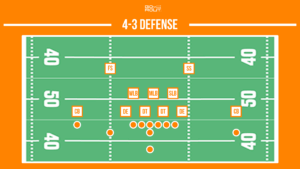
A 4-3 defensive formation consists of:
- Four defensive linemen
-
- Two defensive tackles on the interior
-
- Two defensive ends on the exterior
- Three linebackers
-
- One middle linebacker
-
- Two outside linebackers
- Two cornerbacks
- Two safeties
This is one of the most common base defensive formations in football, particularly in advanced leagues like college football and the National Football League (NFL). It provides a balanced attack, allowing the defense to be aggressive against the run but have enough players in coverage to protect against the pass.
The defensive line and linebackers are the foundation of 4-3 defense.
- Defensive ends generate an outside pass rush attack to pressure the quarterback and force bad decisions. They set the edge, containing any rushes to the outside.
- Defensive tackles clog the interior line, stopping the run at the line of scrimmage and pressuring the quarterback on pass plays.
- Linebackers are “in the box” defending against the run, protecting against screen passes, rushing the quarterback, or dropping into pass coverage.
4-3 defense offers football coaches and defensive coordinators flexibility. It can protect against various offensive formations – from T formation or a double tight end formation to spread formation.
There are opportunities to call man-to-man and zone coverages, depending on the situation. Linebackers can cover the tight end, blitz, or cover short zones to the side and middle. Cornerbacks can blitz to pressure the quarterback, with one of the two deep safeties taking the cornerback’s responsibility. Or the corner can drop into deep coverage allowing the safety to blitz.
3-4 Defense
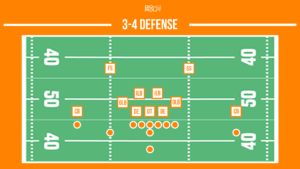
A 3-4 defensive formation consists of:
- Three defensive linemen
-
- One nose tackle
-
- Two defensive ends
- Four linebackers
-
- Two inside linebackers
-
- Two outside linebackers
- Two cornerbacks
- Two safeties
This is another common base formation that airs on the side of caution as a pass defense, placing more emphasis on speed and leveraging faster players.
On the defensive line, there is less “power” because there are fewer bodies. More responsibility lies on the linebackers to cover the run and rush the quarterback. Outside linebackers can serve as hybrid EDGE players – larger and faster to rush the quarterback but still capable of dropping back into coverage.
3-4 defense is more vulnerable to inside runs with less bodies on the line of scrimmage and is better used in short passing situations. The formation adds confusion to the offense as it’s uncertain which linebacker will rush the quarterback.
Football coaches can run a combination of man and zone, making it a flexible defensive formation.
4-4 Defense
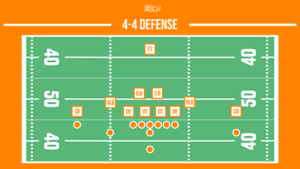
A 4-4 defensive formation consists of:
- Four defensive linemen
-
- Two defensive tackles
-
- Two defensive ends
- Four linebackers
-
- Two inside linebackers
-
- Two outside linebackers
- Two cornerbacks
- One safety
By “stacking the box” with eight players, this formation is designed to defend the running game. Four defenders cover the line of scrimmage and set the edge while four linebackers protect against wide runs to the outside and ball carriers that escape the defensive line.
In this formation, outside linebackers serve as a hybrid. They protect against runs to the outside but are sometimes tasked with covering slot wide receivers, tight ends, or running backs in the passing game .
The 4-4 defense puts a lot of pressure on cornerbacks to cover the pass and leaves defenses susceptible to deep offensive plays through the air.
5-2 Defense
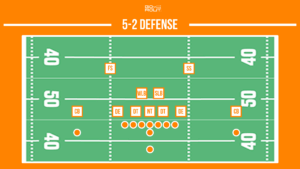
A 5-2 defensive formation consists of:
- Five defensive linemen
-
- One nose tackle
-
- Two defensive tackles
-
- Two defensive ends
- Two linebackers
-
- Two inside linebackers (with one taking the play calling role of a middle linebacker)
- Two cornerbacks
- Two safeties
This formation features a loaded defensive front to stop the run. It’s more popular in youth football, middle school football, and high school football where running is the primary offensive strategy and quarterbacks aren’t fully developed or talented enough to beat defenses through the air.
In this alignment, linebackers need to be strong tacklers. If the back gets through the line of scrimmage, there are only two linebackers to stop them from breaking away. Like the 4-4 defense, there’s pressure on the cornerbacks and safeties to protect against big pass plays.
Even though there are four defensive backs in the secondary, one less linebacker makes the defense more vulnerable through the air.
Pass-First Defensive Formations
In obvious passing situations – or facing teams with a spread offense – defenses may drop into one of several strategic formations. These formations anticipate the pass and prevent teams from getting beat through the air.
Prevent defensive formations sub out linemen or linebackers for additional defensive backs to combat specific schemes or personnel the opposite team features – like spread formation. The two pass-first formations we’ll cover in this resource are nickel defense and dime defense.
Nickel Defense
Nickel defense is one of the most common pass-first formations. It utilizes five defensive backs, therefore the label “nickel” defense, with the additional defensive back coined the “nickelback”. There are two primary variations of nickel defense: 4-2-5 and 3-3-5.
4-2-5 Nickel Defense
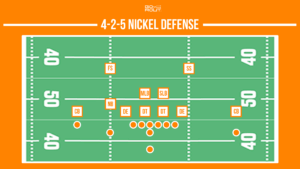
A 4-2-5 defensive formation consists of:
- Four defensive linemen
-
- Two defensive tackles
-
- Two defensive ends
- Two linebackers
-
- Two middle linebackers
- Five defensive backs
-
- One nickelback
-
- Two cornerbacks
-
- Two safeties
This version of nickel defense keeps the line strong, emphasizing pressure on the quarterback and run-stop ability. The primary rush comes from the defensive front and defensive ends are tasked with containing the running game on the outside.
3-3-5 Nickel Defense
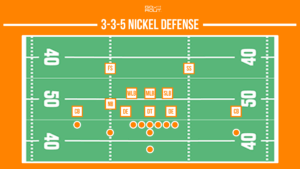
A 3-3-5 defensive formation consists of:
- Three defensive linemen
-
- One nose tackle
-
- Two defensive ends
- Three linebackers
-
- One middle linebacker
-
- Two outside linebackers
- Five defensive backs
-
- One slot cornerback (nickelback)
-
- Two cornerbacks
-
- Two safeties
By removing a lineman, this variation of nickel defense combats the passing attack but leaves teams vulnerable to the run. Three linemen handle the primary rush and control the running lanes. Linebackers are tasked with support in stopping the run, blitzing the quarterback for pressure, and reacting to the play as it develops in coverage.
Because there’s an opportunity for eight defensive players to drop back in coverage, 3-3-5 defense can be used to protect against deep passes. It’s a give and take – defenses might give up yardage in return for protecting against big plays.
Dime Defense
Dime defense adds a sixth defensive back called the “dimeback” – therefore its name. Teams use this type of defensive formation in passing situations when there are four or more receivers. There are variations of dime defense that teams use.
Dime Defense Variation 1 consists of:
- Four defensive linemen
-
- Two defensive tackles
-
- Two defensive ends
- One linebacker
- Six defensive backs
-
- Two slot cornerbacks (nickelback and dimeback)
-
- Two cornerbacks
-
- Two safeties
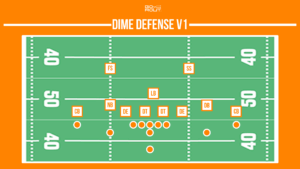
Dime Defense Variation 2 consists of:
- Three defensive linemen
-
- One nose tackle
-
- Two defensive ends
- Two linebackers
- Six defensive backs
-
- Two slot cornerbacks (nickelback and dimeback)
-
- Two cornerbacks
-
- Two safeties
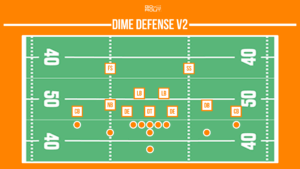
Both variations of dime defense aim to defend against the pass. Variation 1, with four defensive linemen, protects against the run game. Variation 2, with only three defensive linemen, leaves the defense more vulnerable to the rushing attack.
Some scenarios where dime defense is useful include:
- The opposing team’s running game is ineffective
- Second or third-and-long situations where teams are likely to pass
- Late-game situations when time is a factor or when the opponent is forced to go for fourth-and-long to keep the game alive
Other Football Defensive Formations
Outside of the formations already mentioned, there are a few less commonly used defenses including:
- 46
- 5-3
- 6-2
46 Defense
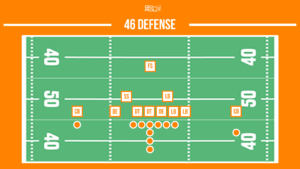
A 46 defensive formation consists of:
- Four defensive linemen
-
- Two defensive tackles
-
- Two defensive ends
- Three linebackers
-
- One middle linebacker
-
- Two outside linebackers
- Two cornerbacks
- Two safeties
By moving the strong safety up into the box to serve the same position as a fourth linebacker, 46 defense creates a 4-4 formation using 4-3 personnel.
The two outside linebackers line up on the tight end’s side of the offensive line, outside of the defensive end. The middle linebacker stays off the line of scrimmage alongside the strong safety, while the free safety remains the sole safety net against deep passes.
46 defensive is one of the only defensive formations that doesn’t follow the number of linemen-number of linebackers naming convention.
5-3 Defense
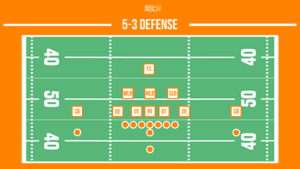
A 5-3 defensive formation consists of:
- Five defensive linemen
-
- One nose tackle
-
- Two defensive tackles
-
- Two defensive ends
- Three linebackers
-
- One middle linebacker
-
- Two outside linebackers
- Two cornerbacks
- One safety
Aimed at stopping the run, 5-3 defense leverages linebackers and an additional lineman to stack the box with a loaded defensive front.
6-2 Defense
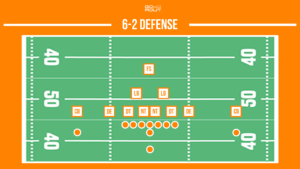
A 6-2 defensive formation consists of:
- Six defensive linemen
-
- Two nose tackles
-
- Two defensive tackles
-
- Two defensive ends
- Two linebackers
-
- Two inside linebackers
- Two cornerbacks
- One safety
This type of defensive formation is common in goal line sets or short yardage situations. By loading the defensive line with six players, teams protect heavily against the run to keep teams out of the end zone or prevent a first down. Specifically, this formation tries to clog the line of scrimmage and stop inside runs.
Linebackers play the run first, but protect against the pass if needed. Defensive backs serve the opposite role – there to protect the pass but play the run as their secondary responsibility.
Defensive Formation FAQs
What is the 4-2-5 formation?
The 4-2-5 is a defensive formation in football with four defensive linemen, two linebackers, and five defensive backs. It’s one type of nickel defense, with an additional fifth defensive back called the “nickel back”.
Which is the best defensive formation in football?
The best defensive formation depends on the team you’re playing, the strengths of your team, game situations, and other factors.
In general, The two most common base formations on defense are 4-3 and 3-4. These defensive formations provide balanced protection against the run and pass, and teams can run man-to-man or zone out of it.
What is 4-3 defense?
The 4-3 defensive is a base formation with four defensive linemen, three linebackers, and four defensive backs.
What is the dime defense formation?
The dime defense is a formation that adds two additional defensive backs, leading to a total of six defensive backs. Teams either pair four defensive linemen and one linebacker, or three defensive linemen and two linebackers, with the six defensive backs.
The formation with more linemen better protects against the run, while the one with three linemen focuses more on pass coverage.







